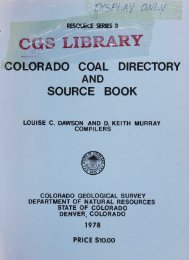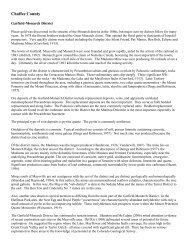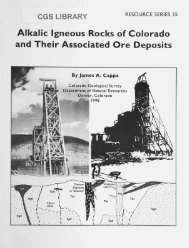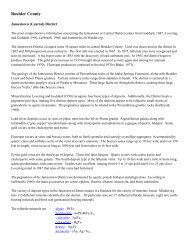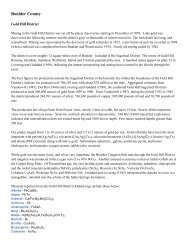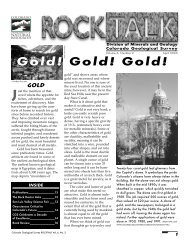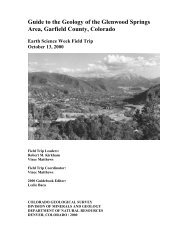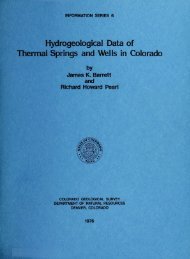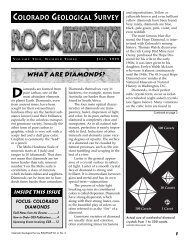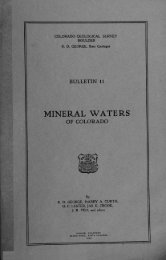Marble - Colorado Geological Survey
Marble - Colorado Geological Survey
Marble - Colorado Geological Survey
You also want an ePaper? Increase the reach of your titles
YUMPU automatically turns print PDFs into web optimized ePapers that Google loves.
esult of brecciation, or fracturing, which has<br />
allowed an influx of foreign material into a<br />
body of marble. In general, the white marbles<br />
are derived from pure calcitic or dolomitic limestones<br />
and tend to be the most free of impurities.<br />
Red, pink, or red-brown coloration is generally<br />
caused by manganese oxides or hematite.<br />
Yellow, yellow-brown, or cream color variations<br />
are usually due to limonite. Gray to black tints<br />
are caused by carbonaceous material contained<br />
in the rock matrix (Bowles, 1958). Green shades<br />
are due to the presence of micas, chlorite,<br />
and/or silicates (MIA, 1985). A list of secondary<br />
minerals frequently found in marbles would<br />
include: brucite, diopside, epidote, feldspars,<br />
forsterite, graphite, grossularite, humite, periclase,<br />
phlogopite, pyrite, quartz, scapolite, serpentine,<br />
sphene, spinel, talc, tremolite, vesuvianite,<br />
and wollastonite (Dietrich and Skinner,<br />
1979). The marble which occurs on the subject<br />
property can be subdivided into many different<br />
colors. The most prevalent is white marble<br />
followed by a medium gray marble which was<br />
previously mined. The amount of white marble<br />
is misleading to even the casual field observer<br />
because much of the white marble outcrops<br />
have a medium gray stained or weathered rind<br />
.5 inch to 1 inch thick. CGS also encountered<br />
other marble of various shades of gray, green,<br />
and a fine grained dark gray which was the<br />
closest to black. None of the marbles were a<br />
true black and no such true black is expected.<br />
Texture<br />
The texture of marble is the size, degree of uniformity,<br />
and arrangement of constituent minerals.<br />
Grain sizes may range from fine (greater<br />
than one milimeter), to medium (one to five<br />
milimeters), to coarse (greater than five milimeters)<br />
for both calcitic and dolomitic marbles.<br />
The marbles of the project area all appear to<br />
fall into the medium grain category. Where calcite<br />
and dolomite marbles occur together, the<br />
calcite grains tend to be the more coarse. Also,<br />
calcitic marbles tend to display anhedral, interlocking<br />
grains with mosaic or sutured boundaries<br />
whereas the dolomitic marbles tend to be<br />
more granular or saccharoidal (Dietrich and<br />
28<br />
Skinner, 1979). Degree of uniformity can be variable,<br />
ranging from equigranular, to non-equigranular,<br />
to porphyritic textures in which large<br />
euhedral grains are enclosed in a smaller<br />
grained ground mass. None of the marbles<br />
mapped fell into this category. All were equigranular<br />
throughout the thickness of the bed<br />
but might grade into finer or coarser grain size<br />
over a long strike distance. The type, distribution,<br />
and geometry of grains, along with the<br />
nature of grain boundaries, is important in that<br />
they will determine the relative physical properties<br />
of a marble.<br />
Translucence<br />
Certain varieties of marble will allow light to<br />
penetrate into the rock structure, creating a<br />
very aesthetic "glow". This is a most desirable<br />
quality in statuary marbles, some of which<br />
have light penetration ranges on the order of .5<br />
to 1.5 inch (Bowles, 1958). Some marbles have<br />
a "waxy" luster which may also be attributable<br />
to translucence. None of the polished samples<br />
of the <strong>Colorado</strong>-Highland <strong>Marble</strong> quarry appear<br />
to have significant translucence.<br />
Rift-graln<br />
The terms "rift" and "grain", when applied to<br />
marble, are essentially synonymous and refer<br />
to the direction(s) of easiest breakage or cleavage.<br />
Frequently rift parallels bedding and is<br />
probably caused by elongation of grains due to<br />
pressure. The presence of platy or fibrous secondary<br />
minerals, such as micas or actinolite,<br />
will enhance rift because of preferred orientations<br />
along axes of grain elongation (Bowles,<br />
1958). Rift direction has been an historically<br />
important consideration in quarry planning but<br />
is recently becoming less important because of<br />
the advent of modern diamond saws in the separation<br />
of quarry blocks. As previously mentioned,<br />
rift in <strong>Colorado</strong>-Highland marbles is<br />
parallel to bedding, where present.<br />
Soundness<br />
The dimension of blocks to be quarried from a<br />
particular deposit is greatly controlled by joint<br />
spacing. Joints which are encountered in most



